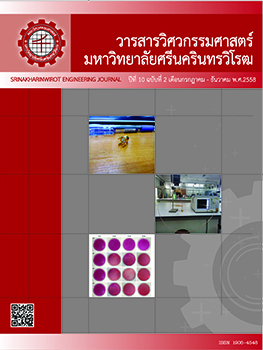แบบจำลองโครงข่ายประสาทเทียมสำหรับคลอรีนอิสระคงเหลือ โดยใช้ข้อมูลของการประปาบางเขนเป็นกรณีศึกษา
Abstract
บทคัดย่อ งานวิจัยนี้มีวัตถุประสงค์ในการประยุกต์ใช้โครงข่ายประสาทเทียม (Artificial Neural Networks) ในการสร้างแบบจำลองทางคณิตศาสตร์ทำนายค่าคลอรีนอิสระคงเหลือ (Free Residual Chlorine) โดยจุดประสงค์หลักของแบบจำลองจะนำไปใช้ในการฝึกผู้ปฏิบัติงานที่ไม่มีประสบการณ์ในการควบคุมระบบจ่ายคลอรีน ในการสร้างแบบจำลองทางคณิตศาสตร์นี้จะใช้ข้อมูลอนุกรมเวลาในการเดินระบบจ่ายคลอรีนของโรงผลิตน้ำประปาบางเขน การประปานครหลวง ข้อมูลในการเดินระบบนี้เป็นข้อมูลรายวันโดยเก็บเป็นระยะเวลา 1 ปี ตั้งแต่วันที่ 1 มกราคม พ.ศ. 2553 ถึง วันที่ 31 ธันวาคม พ.ศ. 2553 ในการสร้างแบบจำลองโครงข่ายประสาทเทียมได้ทำการแบ่งข้อมูลออกเป็น 3 ส่วน คือ Training Set, Test Set และ Validation Set เพื่อเป็นข้อมูลในการสอน การทดสอบแบบจำลองเพื่อเปรียบเทียบประสิทธิภาพและลดการเกิด Over Fitting ของแบบจำลอง โดยสอนแบบจำลองให้เกิดการเรียนรู้ ด้วยเทคนิคการแพร่กระจายย้อนหลัง (Back Propagation Learning) การวัดประสิทธิภาพของแบบจำลองทำได้โดยการเปรียบเทียบค่า Coefficient of Determination และค่า Mean Absolute Error ของชุดข้อมูล Test Set จากผลการวิจัยพบว่าแบบจำลองโครงข่ายประสาทเทียมที่มีประสิทธิภาพการทำนายที่ดีที่สุด เป็นแบบจำลองแบบสองชั้นซ่อน โดยมีจำนวนโหนดเท่ากับ 50 และ 90 โหนด ในชั้นซ่อนที่หนึ่งและสองตามลำดับ แบบจำลองนี้ให้ผลการทำนายที่ดีมากโดยมีค่า Coefficient of Determination เท่ากับ 0.99 และค่าความผิดพลาดMean Absolute Error เท่ากับ 0.02 มิลลิกรัมต่อลิตร คำสำคัญ: โครงข่ายประสาทเทียม คลอรีน อนุกรมเวลา ABSTRACT The objective of this research is to apply Artificial Neural Network Constructing for mathematical model to predict Free Residual Chlorine. The main purpose of the model is to train unexperienced operators in the control of chlorination system. The mathematical model was constructed by using Time Series operation data collected from the Metropolitan Waterworks Authority. The data was collected daily from 1st January 2010 to 31th December 2010. In constructing the Artificial Neural Network Model, the input data was divided into 3 sets: Training Set, Test Set, and Validation Set, in order to be used for teaching, testing the model efficiency, and reducing over fitting. Back Propagation learning was applied in training the model while model performance was evaluated by using the Coefficient of Determination and the Mean Absolute Error of the data in the Test Set. The results reveal that the Artificial Neural Network Model with two hidden layers obviously shows the best performance, with 50 nodes in the first hidden layer and 90 nodes in the second hidden layer. The model gives excellent prediction as reflected by a Coefficient of Determination of 0.99 and a Mean Absolute Error of 0.02 milligrams per liter. Keyword: Artificial neural networks, Chlorine, Time seriesDownloads
Download data is not yet available.
Downloads
Published
2016-01-29
Issue
Section
บทความวิจัย
License
ลิขสิทธิ์เป็นของวารสารวิศวกรรมศาสตร์ มหาวิทยาลัยศรีนครินทรวิโรฒ





